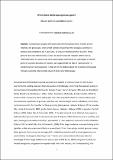Where have all the (ape) gestures gone?
Abstract
Comparative analysis of the gestural communication of our nearest animal relatives, the great apes, implies that humans should have the biological potential to produce and understand 60–70 gestures, by virtue of shared common descent. These gestures are used intentionally in apes to convey separate requests, rather than as referential items in syntactically structured signals. At present, no such legacy of shared gesture has been described in humans. We suggest that the fate of “ape gestures” in modern human communication is relevant to the debate regarding the evolution of language through a possible intermediate stage of gestural protolanguage.
Citation
Byrne , R W & Cochet , H 2017 , ' Where have all the (ape) gestures gone? ' , Psychonomic Bulletin & Review , vol. 24 , no. 1 , pp. 68-71 . https://doi.org/10.3758/s13423-016-1071-0
Publication
Psychonomic Bulletin & Review
Status
Peer reviewed
ISSN
1069-9384Type
Journal article
Collections
Items in the St Andrews Research Repository are protected by copyright, with all rights reserved, unless otherwise indicated.

